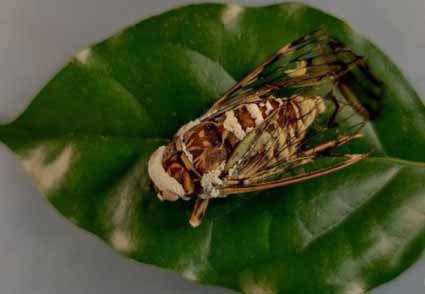Abstract
We conducted morphological evaluations and multi-locus phylogenetic analyses of SSU, LSU, EF-1a, RPB1 and RPB2 genes for Metarhizium strains infecting adult cicada from Guniujiang Nature Preserve, southeastern China. A new species Metarhizium macrosemiae is described. M. macrosemiae is the phylogenetic sister species of M. chaiyaphumense / M. takense. M. macrosemiae is distinguished morphologically from M. chaiyaphumense by its host, growth rate on agar, and size of the phialides. It differs significantly from M. takense in colony colour, growth rate on agar, and the presence of macroconidia on SDYA/4. Additionally, comparison of five gene sequences with those of M. guniujiangense type strain revealed that two strains on adult cicada are asexual morph of M. guniujiangense. We illustrate and describe this previously unreported asexual morph of M. guniujiangense on adult cicada.
References
<p>Castlebury, L.A., Rossman, A.Y., Sung, G.H., Hyten, A.S. & Spatafora, J.W. (2004) Multigene phylogeny reveals new lineage for <em>Stachybotrys chartarum</em>, the indoor air fungus. <em>Mycological Research </em>108 (8): 864–872. https://doi.org/10.1017/S0953756204000607</p>
<p>Guo, H.L., Ye, B.L., Yue, Y.Y., Chen, Q.T. & Fu, C.S. (1986) Three new species of <em>Metarhizium. Acta Mycologica Sinica</em> 5 (3): 177–184.</p>
<p>Hall, T.A. (2007) BioEdit. Biological Sequence Alignment Editor for Win95/98/NT/2K/XP. Carlsbad, CA: Ibis Biosciences. [http://www.mbio.ncsu.edu/BioEdit/bioedit.html]</p>
<p>Huang, B., Li, C., Humber, R.A., Hodge, K.T. & Li, Z.Z. (2005) Molecular evidence for the taxonomic status of <em>Metarhizium taii</em> and its teleomorph,<em> Cordyceps taii </em>(Hypocreales, Clavicipitaceae). <em>Mycotaxon</em> 94 (3): 137–147. https://doi.org/10.1007/s11046-005-6871-0</p>
<p>Katoh, K. & Standley, D.M. (2013) MAFFT multiple sequence alignment software version 7: improvements in performance and usability. <em>Molecular Biology and Evolution </em>30 (4): 772–780. https://doi.org/10.1093/molbev/mst010</p>
<p>Kepler, R.M., Humber, R.A., Bischoff, J.F. & Rehner, S.A. (2014) Clarification of generic and species boundaries for <em>Metarhizium</em> and related fungi through multigene phylogenetics.<em> Mycologia </em>106 (4): 811–829. https://doi.org/10.3852/13-319</p>
<p>Kobayasi, Y. (1939) On the genus <em>Cordyceps</em> and its allies on <em>Cicadae</em> from Japan. <em>Bulletin of the Biogeographical Society of Japan </em>9: 145–176.</p>
<p>Kobayasi, Y. & Shimizu, D. (1963) Monographic studies of <em>Cordyceps</em> 2. Group parasitic on<em> Cicadidae</em>. <em>Bulletin of the National Science Museum, Tokyo</em> 6: 286–314.</p>
<p>Lacey, L., Frutos, R., Kaya, H. & Vail, P. (2001) Insect pathogens as biological control agents: do they have a future? <em>Biological Control</em> 21: 230–248. https://doi.org/10.1006/bcon.2001.0938</p>
<p>Liang, Z.Q., Liu, A.Y. & Liu, J.L. (1991) A new species of the genus <em>Cordyceps</em> and its <em>Metarhizium</em> anamorph.<em> Acta Mycologica Sinica</em> 10 (4): 257–262.</p>
<p>Liu, Z.Y., Liang, Z.Q., Whalley, A.J.S., Yao, Y.J. & Liu, A.Y. (2001) <em>Cordyceps brittlebankisoides</em>, a new pathogen of grubs and its anamorph, <em>Metarhizium anisopliae</em> var. <em>majus</em>.<em> Journal of Invertebrate Pathology</em> 78 (3): 178–182. https://doi.org/10.1006/jipa.2001.5039</p>
<p>Luangsa-ard, J.J., Mongkolsamrit, S., Thanakitpipattana, D., Khonsanit, A., Tasanathai, K., Noisripoom, W. & Humber, R.A. (2017) Clavicipitaceous entomopathogens: new species in <em>Metarhizium</em> and a new genus <em>Nigelia</em>. <em>Mycological Progress </em>16 (4): 369–391. https://doi.org/10.1007/s11557-017-1277-1</p>
<p>Mongkolsamrit, S., Khonsanit, A., Thanakitpipattana, D., Tasanathai, K. & Luangsa-ard, J.J. (2020) Revisiting <em>Metarhizium</em> and the description of new species from Thailand. <em>Studies in Mycology </em>95: 171–251. https://doi.org/10.1016/j.simyco.2020.04.001</p>
<p>Nylander, J.A.A. (2004) MrModeltest v2. Program distributed by the author. Evolutionary Biology Centre, Uppsala University. Available from: https://github.com/nylander/MrModeltest2 (accessed 5 December 2022)</p>
<p>Ronquist, F. & Huelsenbeck, J.P. (2003) Mrbayes 3: Bayesian phylogenetic inference under mixed models. <em>Bioinformatics</em> 19: 1572–1574. https://doi.org/10.1093/bioinformatics/btg180</p>
<p>Shrestha, B., Tanaka, E., Hyun, M.W., Han, J. & Gh, S. (2017) <em>Cordyceps</em> species parasitizing Hymenopteran and Hemipteran insects. <em>Mycosphere</em> 8 (9): 1424–1442. https://doi.org/10.5943/mycosphere/8/9/8</p>
<p>Stamatakis, A. (2104) RAxML version 8: a tool for phylogenetic analysis and post-analysis of large phylogenies. <em>Bioinformatics </em>30 (9): 1312–1313. https://doi.org/10.1093/bioinformatics/btu033</p>
<p>Sung, G.H., Hywel-Jones, N.L., Sung, J.M., Luangsa-ard, J.J. Shrestha, B. & Spatafora, J.W. (2007) Phylogenetic classification of<em> Cordyceps</em> and the Clavicipitaceous fungi. <em>Studies in Mycology</em> 57 (1): 5–59. https://doi.org/10.1016/S0166-0616(14)60128-7</p>
<p>Swofford, D.L. (2003) PAUP*: Phylogenetic analysis using parsimony and other methods. Version 4. Sunderland, Massachusetts: Sinauer Associates.</p>
<p>Thanakitpipattana, D., Tasanathai, K., Mongkolsamrit, S., Khonsanit, A. & Luangsa-ard, J.J. (2020) Fungal pathogens occurring on Orthopterida in Thailand. <em>Persoonia</em> 44: 140–160. https://doi.org/10.3767/persoonia.2020.44.06</p>
<p>Tzean, S.S., Hsieh, L.S., Chen, J.L. & Wu, W.J. (1992) <em>Nomuraea viridulus</em>, a new entomogenous fungus from Taiwan. <em>Mycologia</em> 84: 781–786. https://doi.org/10.1080/00275514.1992.12026204</p>
<p>White, T.J., Bruns, T., Lee, S. & Taylor, J. (1990) Amplification and direct sequencing of fungal ribosomal RNA genes for phylogenetics. <em>PCR protocols: a guide to methods and applications </em>18 (1): 315–322. https://doi.org/10.1016/B978-0-12-372180-8.50042-1</p>
<p>Yamamoto, K., Ohmae, M. & Orihara, T. (2020) <em>Metarhizium brachyspermum</em> sp. nov. (Clavicipitaceae), a new species parasitic on Elateridae from Japan. <em>Mycoscience</em> 61 (1): 37–42. https://doi.org/10.1016/j.myc.2019.09.001</p>


